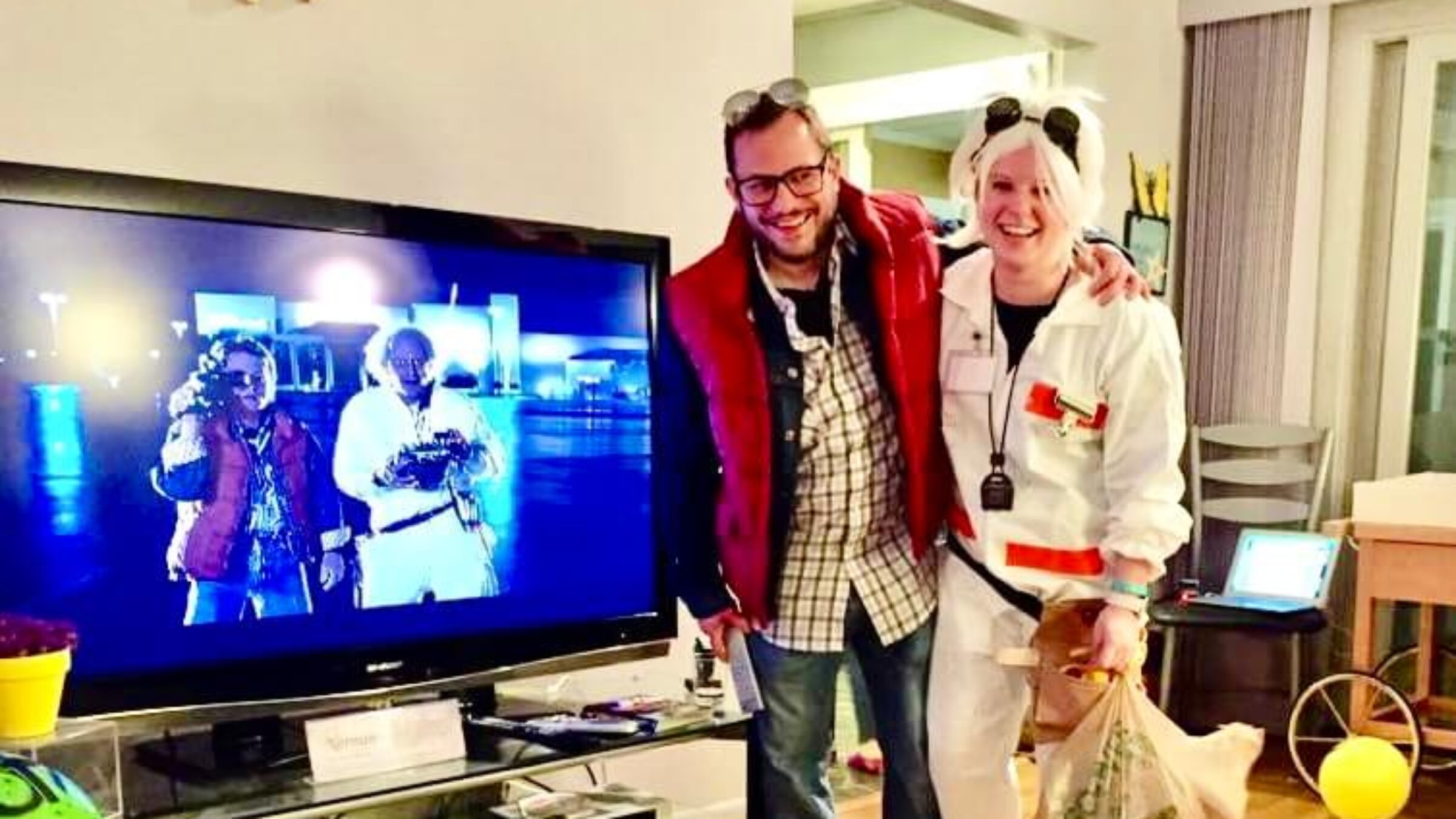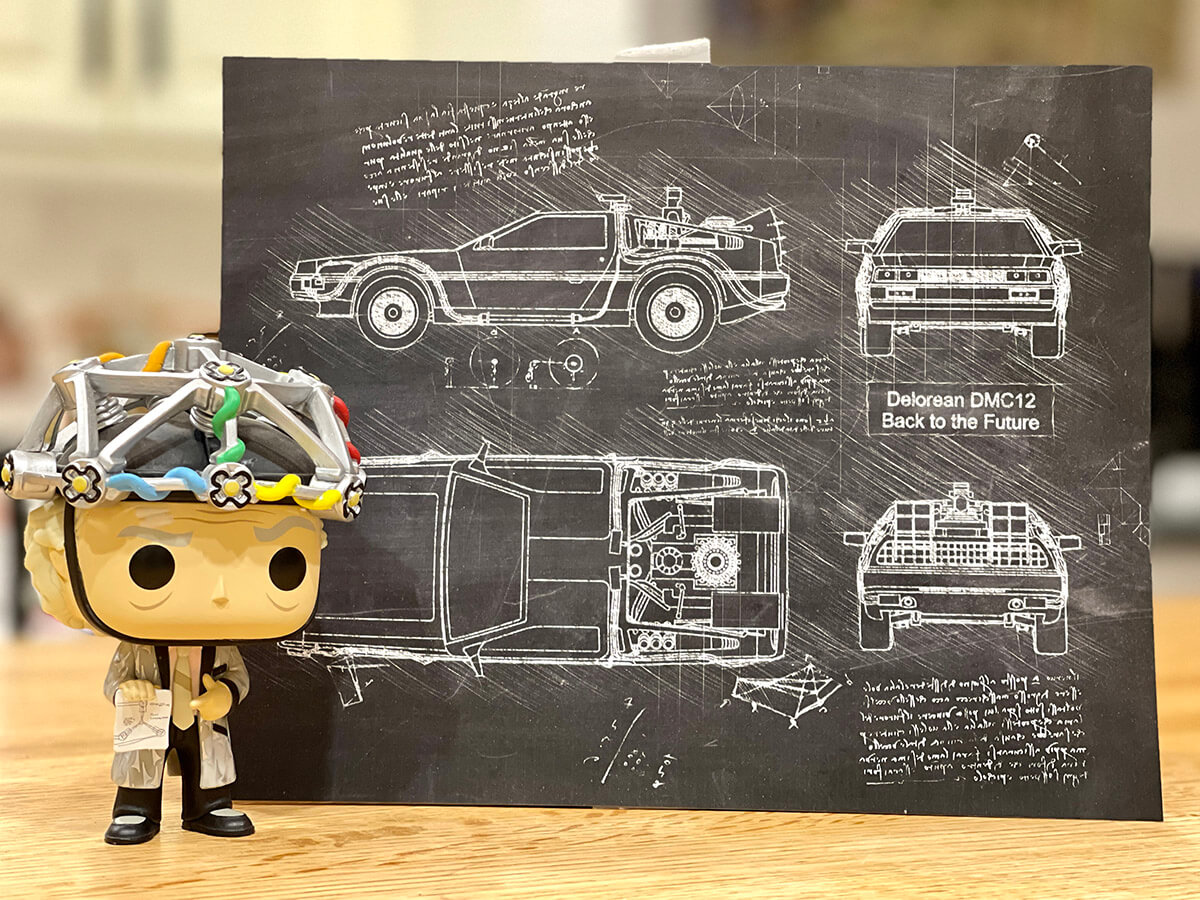FIRST PERSONOn sitting shiva and watching ‘Back to the Future’
After my mom died, all I wanted was to hop in a time machine

Benyamin and Elizabeth Cohen, in costume as Marty McFly and Doc Brown from ‘Back to the Future.’ Courtesy of Benyamin Cohen
God forbade me from seeing “Back to the Future Part II.” At least, that’s what I was told by my dad, a rabbi, whose admonitions against eating Nerds candy (not kosher) and watching “Pretty Woman” (um, also not kosher) were delivered with divine inspiration.
But the 1989 release of the second film in Michael J. Fox’s time-travel trilogy was verboten not for its content — it was, after all, rated PG — but for its timing. It debuted mere months after my mother died. Under strict interpretation of Jewish law, the first year of mourning for those who lose a parent means not going to parties, concerts — movie theaters.
I missed the openings of lots of movies in 1989: “Weekend at Bernie’s,” “Honey, I Shrunk the Kids,” and “Indiana Jones and the Last Crusade” — a cinematic canon I would, of course, eventually catch up with. But “Back to the Future” was different. When the original came out four years earlier, when I was 10 years old, my brother Dani, who had recently gotten his driver’s license, took me to the theater to see it multiple times. (This was BBE — Before the Blockbuster Era.)
I assume everyone who wants to has seen the movie by now, so I don’t feel like I’m spoiling anything by running through the major plot points: There’s a scientist named Doc Brown who has somehow managed to convert a DeLorean into a time machine, thanks to an invention dubbed the “flux capacitor.”
Through a series of events that involve Libyan terrorists looking for plutonium in a mall parking lot (ah, to be a screenwriter in the 1980s), the DeLorean gets put to the test. Its first human occupant? Marty McFly, Brown’s young friend played by Fox, and he’s headed to 1955. That’s where he bumps into his parents, who are in high school, and he unwittingly interrupts their courtship.
Marty’s presence in their lives accidentally changes the course of his family’s history, and he spends the remainder of the movie trying to make sure his mom and dad attend the school dance together, have their first kiss, and fall in love — thereby ensuring his own very existence.
The film left an indelible mark on millions of people, many of whom celebrate Back to the Future Day each Oct. 21 — a date in the film in which Marty travels through time. For me, the film changed the aperture of how I saw the world. Up until that point, I had seen movies that took place in reality: “The Karate Kid,” “The Black Stallion,” “Kramer vs. Kramer.” (Yes, my parents took me to see “Kramer vs. Kramer”; I guess they couldn’t find a babysitter that day.)
But “Back to the Future” was something entirely different. It bent genres and colored outside the lines. It showed me that anything was possible, and it became my guiding principle. I began writing fantasy novels (none published, although, fingers crossed, they still exist on a floppy disk in a dust-covered box in my attic), I launched a high school newspaper, and taught myself to skateboard so I could be like Marty in the movie. The shortest guy in school, I somehow wiggled my way onto the basketball team. Like I said, anything was possible.
I have since become obsessed with the whole genre of time-travel movies and TV shows. When NBC was thinking about canceling “Timeless,” a series about a ragtag team that travels back in time to stop an evil corporation from changing history, I was one of the many die-hard fans who were part of a campaign to bring it back. (NBC acquiesced!) All of this — the DeLorean, the skateboarding, my pitiful plea to a major TV network — fueled a lifetime of fascination with time travel.

The year 1989, when I was 13, began with the best of prospects: I had raked in thousands of dollars worth of Israel Bonds at my bar mitzvah so, you know, the world was my oyster. Not to mention, the highly anticipated sequel to my favorite movie was on the horizon. Then one Tuesday, a Tuesday that seemed like any other Tuesday, while I sat in my Talmud class learning if one could build a kosher sukkah on the back of a camel, my mom had a fatal brain aneurysm.
Months earlier, I had become a man in the eyes of Judaism. And now, well, now I was curled up in the fetal position. Never did I wish for a time machine more than at that precise moment.
What I wouldn’t give to hop into a DeLorean and see my mother one more time, to have one final conversation with her. How would I use that gift of time? Would I share my life’s goals and dreams with her? Would it be possible to warn her of her fate?
Time travel, of course, would be useful outside of such dark and deep moments. There are instances when we all wish we could hit an “undo” button in life, like we do with command-Z on a computer. Said something stupid at work? Just hop into the DeLorean and go back five minutes, before you embarrassed yourself in front of your boss.
“Back to the Future Part II” was released 11 months after my mom’s funeral, which meant, by dint of divine decree, I couldn’t see it right away. Thankfully, this was in the days before social media, so I wasn’t concerned about potentially reading spoilers online. Heck, the words “spoilers” and “online” weren’t even in my lexicon yet.
I watched — rueful, jealous — as others got to witness the next chapter in Marty’s story. To see a future of flying cars and hoverboards. Instead, I went to synagogue three times a day to recite the kaddish prayer. Thankfully, my best friend, Chaim, waited out of solidarity to see the movie until my year of mourning was over. We went to the theater together the very next day.
In “Back to the Future Part II,” Marty travels ahead to 2015 to see how his own future turns out. For my 40th birthday party, which also took place in 2015, my wife threw me a surprise “Back to the Future”–themed party. Everyone arrived in costume as characters from the film.
I, of course, was Marty. My wife, in a wig reminiscent of Albert Einstein, was Doc Brown. As I type this, I’m literally wearing a “Back to the Future” T-shirt while, in my office, I’m surrounded by artwork and knickknacks from the trilogy. Yes, I have the schematics for the flux capacitor framed on my wall.
If my wife is reading this, all I want for my 50th birthday is a ride in a DeLorean. That, and a chance to see “Back to the Future” through the eyes of my younger self.






















